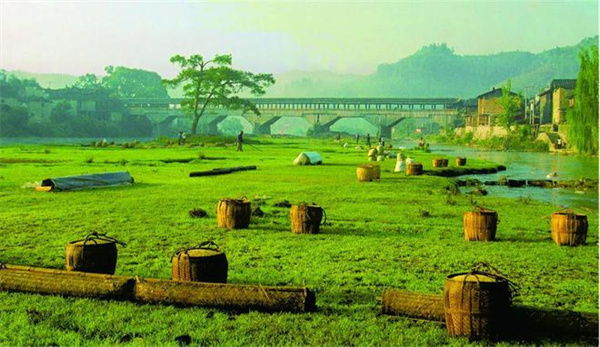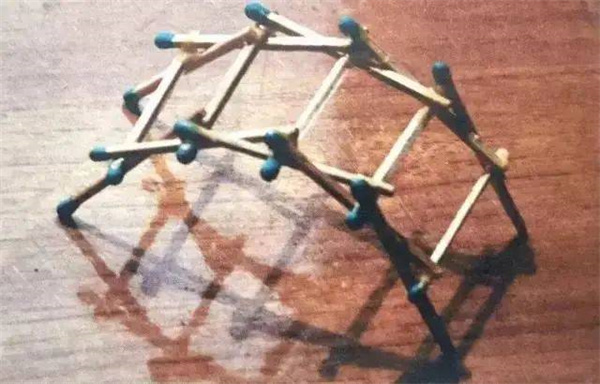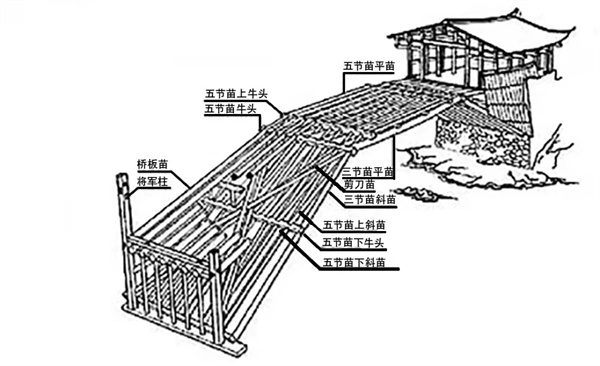The history of the wooden arch bridge behind the burning Wan'an Bridge: It is the "living attitude" and "Li Shuihong Bridge" in "The Map of the River in Qingming". It was popular in the Central Plains in the Central Plains nearly a thousand years ago.
Author:Mammoth video Time:2022.08.08
Elephant reporter Li Changxue
On the evening of August 6, the national key cultural relics protection units and the longest existing wooden arcade bridge in China suddenly fire suddenly. , No casualties.

(Before the Wan'an Bridge was burned, it was not burned.
In the fire, people witnessed the collapse of the Wanan Bridge, and couldn't help sighing: the masterpiece of the wooden corridor bridge of "a variety in the history of the world bridge", and the "'living fossils' in the history of ancient bridges in my country", Wanan Bridge has extremely high historical value, cultural value and artistic value, but now it has been burned by a fire.
The burned Wan'an Bridge and the wooden arch bridge behind them are reminiscent of the "Laoshui Hongqiao" in "The Map of the River in Qingming". Is "Lishui Hongqiao" real? How did it disappear for more than 800 years? Is it related to the burned Wan'an Bridge and the wooden arcade bridge behind it?
Is the "Laoshui Hongqiao" in "The River Map of Qingming" real?
Wan'an Bridge is located in Changqiao Village, Changqiao Township, Pingnan County, Fujian Province. It was formerly known as "Longjiang Gongji Bridge". It was later renamed "Rainbow Bridge" and is now known as "Wan'an Bridge". According to a stone inscription embedded in the pier in the middle of the bridge, the bridge was built in "Yuanyou Five Years (1090) Gengwu September". Based on this time, Wan'an Bridge and the "Rainbow Hongqiao" in "The River Map of Qingming" can be regarded as architecture of the same era.

(Luanshui Hongqiao in the Map of the River in Qingming.
Among the more than 100 wooden arcade bridges found in Fujian, Zhejiang, Wan'an Bridge can be regarded as a typical representative of the wooden arcade bridge. But this kind of wooden arch bridge has nothing to do with the "Rainbow Bridge" in "The River Map of Qingming"?
"Qingming Shanghe Tu" is one of the top ten famous paintings in China. In 1101, it was painted by Zhang Xuanduan, a Northern Song Dynasty painter, and in the form of a long volume and adopting a scattered perspective composition method to vividly record the capital of the Twelfth Century Northern Song Dynasty (now Kaifeng, Henan Province, Henan, Henan (Kaifeng, Henan Province ) The urban appearance and the living conditions of the people at all levels of the society at that time were the witness of the prosperity of the capital of the capital of the Northern Song Dynasty, and it was also a portrayal of the economic situation of the Northern Song Dynasty.
The wooden structure flying bridge across the sidelines across the water of the water in the "Picture of the River in Qingming" is the "painting eye" of the whole painting. Because of this wooden bridge, it not only condensed the prosperity of Jingjing City at that time, but also represents the apex of glory in the history of ancient bridge architecture in my country.
In the history of Chinese bridges, "Yanshui Hongqiao" is also famous for its superb skills and clever structures. Daguqiao, but no longer exist.
In 1953, when the "Qingming Shanghe Tu" was exhibited for the first time, the bridge expert Tang Huancheng first noticed the "Lishui Rainbow Bridge" in the painting. He was also deeply attracted by him: Hesan Bridge, but a lightweight and beautiful wooden arch bridge, "a shiny, making people bright."
After seeing this bridge, a series of questions that need to be verified in Tang Huancheng's brain: Is this a bridge imagined by a literati or a real bridge? What is the structure of the bridge? Bridge?
Later, Tang Huancheng conducted research and calculation of the "Lishui Hongqiao", which confirmed that this wooden arch bridge technology is feasible. The bridge in the painting is real. Mi, about 8 meters wide ", and named it" Die Liang Arch Bridge "and" Guanmu Arch Bridge ". In 1958, he was also rebuilt in the Lianhua Lake Park of Hanyang Bridge in Wuhan Yangtze River Bridge. This "Yishui Hongqiao" span 12 meters, and according to the Hongqiao Bridge across the size of the Hongqiao Bridge in the "Qingming River Map", the maximum diameter of the Hongqiao arch bone is 30 cm in diameter. From this we can imagine that the "Lishui Hongqiao" at that time was quite magnificent.
Tang Huancheng's research and practice has confirmed that the "Youshui Rainbow Bridge" in "The Map of the Qingming River" is true.

(Luanshui Hongqiao in the Map of the River in Qingming.

(Tang Huancheng's structural system of the Yanshui Rainbow Bridge signaling by a match stick.
The "Li Shui Hongqiao", which has disappeared for nearly 800 years, was discovered in Fujian and Zhejiang. Wan'an Bridge is one of them.
In fact, at that time, there were four rivers such as the Luohe River, Huimin River, Wuzhang River, and Jinshui River running through the city, and many bridges were set up on these rivers. "Tokyo Menghua Record" records: "From the seven miles outside Dongshui Gate to the outside of Xishui Gate, there are bridges on the river. From the seven miles outside Dongshui Gate, the bridge has no pillars. Like Feihong ", in many bridges in Liangliang, Hongqiao is just a representative bridge.
In fact, in the Northern Song Dynasty, this Hongqiao was more common in the Central Plains. According to the Song Dynasty Wang Pozhi's "The Record of the Water Yan Yan", the first month of the first year of the Song Dynasty (AD 1017), a man in the Rennian Hall in Tokyo made Wei Huaji, and created a footbridge in the Luohe River, but it was unsuccessful. Fifteen years later, with the support of a priest, with the support of Qingzhou Taishou, it caused the Nanyang Bridge in Qingzhou; after more than ten years, a photo of Chen Xiliang's imitation of Qingzhou Nanyang Bridge built a wooden bridge in Laishui, and gradually gradually gradually gradually gradually built a wooden bridge, and gradually gradually gradually gradually gradually. Promoting to Jingjing, Fen Shui, and Surabaya; after another 25 years, Qingzhou Bridge is still strong, and other places are imitated. This bridge is our Hongqiao style in "The Map of the Qingming River".
This means that Lishui Hongqiao was actually very popular at the time. So, as Tang Huancheng is puzzled, has the bridge such as "Yanshui Hongqiao" still built after the Song Dynasty? Reviewing literature and materials found that "Li Shui Hongqiao" seems to have been lost since the Song Dynasty, because from the Song Dynasty In the future, there will be no record of this bridge. Even the Ming and Qing dynasties's "Qingming Shanghe Tu", the bridge painted is a stone arch bridge.
Since Tang Huancheng found the "Rainbow Rainbow Bridge" in "The Map of the Qingming River", after 27 years of search, he finally inspected in 1980 and found that he was misunderstood as the "eight -character support frame" Zhejiang Yun and Mei Chongqiao and Mei Chongqiao and A series of wooden arch bridges in Fujian and Zhejiang is actually a vein and improvement form of the water Hongqiao Guanwu arch.
The "Hongqiao", which has disappeared for nearly 800 years, has been discovered, which has aroused widespread attention worldwide. These subsequent discovered wooden arch bridges include Wan'an Bridge in Pingnan County. They are called the "living attitude" and "Laoshui Hongqiao" of "Qingming Shanghe Tu".
Wan'an Bridge and other wooden arcade bridges are version 2.0 "Yanshui Hongqiao"
So, why did Hongqiao disappear in the Central Plains region of two or three hundred years?
Wu Shidan, an associate professor of the Xiamen Institute of Arts and Crafts from Fuzhou University, analyzed in his "Wooden Arch Bridge Traditional Creation Technology". Because of the Song Dynasty Nantu and the Yellow River diversion, Hongqiao in the Central Plains region disappeared naturally, and the bridge craftsmanship was lost in the Central Plains. However, the rise of the Fujian Wooden Arcade Bridge is not known to be due to the remoteness of Fujian and Zhejiang and the bridge -making technicians during the Northern Song Dynasty to avoid chaos and be preserved and developed. The structure of the structure of the structure is naturally formed, and it can no longer be verified.
This Hongqiao has taken root in Fujian, Zhejiang and other places, and has nothing to do with local terrain. Taking Fujian as an example, it is known as "Bashan, one water, one point", and there are many valleys, hills, rivers and valleys, and basins in the territory, especially the junction of northeast Fujian and southwestern Zhejiang. The boat is difficult to travel, and the bridge is naturally. And there are many local firs, but you can get materials on the spot.
(Structural diagram of the wooden arch corridor (the "Differential inheritance of the Traditional Creation of Wooden Bridge in the" Non -Heritage "Project — Take Fujian Wooden Gallery Bridge as an example))

However, this kind of wooden arch bridge such as Wan'an Bridge is similar to the "Rainbow Rainbow Bridge" in "The River Map of the Qingming River", but it has higher structural achievements. Essence
Wu Shidan analyzed that first of all, the core construction technology of the wooden arched bridge such as Wan'an Bridge and other wooden arch bridges adopted a more advanced "tenon -and -mortise structure" instead of the brown rope hemp between the horizontal wood and arch stocks used by the Hongqiao Hongqiao. The "tie structure" bundled. Secondly, in the protection of arches, the Central Plains area is raining throughout the year, so the Hongqiao Hongqiao does not require gallery house as shelter; the wooden arch bridge is covered with a gallery house on the bridge surface, so that the key arch wood components can be in the southern mountainous area. , Keep dry in a humid environment, make it durable for a long time, and cleverly use the gravity of the gallery house to rebound up the stress to balance to ensure that the bridge body is stable; third, on the slope of the bridge Large, and more wooden boards, bricks, stone surfaces, etc., the bridge decks are mostly slow -slopes or flat slopes. Finally, in terms of overall stability, there is a side offset problem similar to the traditional Chinese roof frame, while the wooden arcade bridge usually has shear support on the main rod. Displacement and tilt under the action.
In

In addition, local villagers also sacrificed and worshiped the statue of gods on the wooden arch bridge, and provided seats on the bridge for pedestrians to relax, cool down, and even evolve the customs such as the bridge and gathering. The place where life is connected is more humanistic.
- END -
Wenrun Canal | Dongguang: The people's wisdom is lasting

Great Wall Network · Jiyun Client News (Reporter Cui Shang Daiqing Corresponde...
The third case of the hematopoietic stem cell donor of the Qianxianqianqi Banner successfully donated the return
